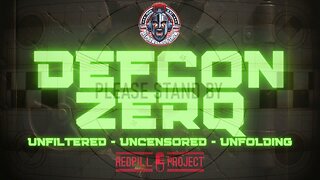Premium Only Content

How to Organize and Label Your Code Book!!!
As we all know, the NFPA 70 (aka NEC code book!) is quite full of a TON of information. Being able to interpret that information is vital to us as electricians so we can do our jobs. But, so is being able to FIND that information! And, as each of us are different in the way we can search for/retain the information located within the NEC, there are a myriad of ways to accomplish this. In this episode of Electrician U, Dustin answers a follower’s question about how he labels his codebooks.
[00:15] - Intro
[01:05] - How I tab MY code book
[02:45] - Where I place tabs.
[03:30] - Highlighting
[04:47] - Tables I like to highlight
[08:00] - Back of the book tabs
[09:47] Merch Messages - Outro
🤘⚡️MEMBERSHIP⚡️🤘
JOIN ELECTRICIAN U - become a member and get:
FREE Continuing Education every year
FREE Practice Exams
FREE Monthly Video Courses
FREE Monthly Educational Newsletter
Premium Members-Only Content
Private Discord Channel
Monthly Members-Only Discord Chats
Sign up here --- https://www.electricianu.com/electrician-u-membership/
🎧🎹MUSIC AND VIDEO:🎹🎧
https://www.facebook.com/descantmv
🎬✍️ART AND ILLUSTRATION:✍️🎬
https://www.daverussoart.com
The first way would be to label the important and most often used sections of the codebook, and we do this in the form of tabbing our books. You can purchase a preprinted set of these tabs at the same place you purchase your codebook, or most electrical supply houses or online stores. You can get color coded tabs that separate different sections by color, or you can get a set of tabs that is a solid color if you so choose. The colored tabs tend to make navigation a bit easier (especially if you are new to the codebook world) as it keeps the sections separated, but usually cost a bit more than the stock tabs. The location of your tabs can also be manipulated; while the tabs are made to be installed on the long edge of the page, it can be useful to put some along the top of the pages for some of your most often used items (I tend to put the tables up there) so you don’t have to surf through ALL the tabs to find the item you are looking for.
Using highlighters is another popular way to identify the information you are looking for within the sea of stark white paper and black writing. It can make certain things POP by drawing your eyes toward the color. A bit of caution here, however, to not OVER highlight as it can do the opposite if you have too much color on the page. So, for instance, if you highlighted T250.66 right above the actual table, it would make it easier to see on the page. You also could highlight the COPPER and Size of Largest Ungrounded Conductor; the Copper as it is typically the most common conductor type, we use and the Size of Largest Ungrounded Conductor as that is how conductor sizing is accomplished on that particular table. Another example is Table 310.16. If you were to highlight the temperature numbers themselves, the copper and aluminum words, and draw a vertical line down the middle (splitting the two different conductor compositions apart from one another) it can make navigation of the table much easier and quicker. Highlighting the different PARTS within a section can also be handy so you are aware when you are entering a different part of the same section.
Another item that can be (and SHOULD be) done to your codebook, is to make notes. Take table 310.15(C)(1) for example. The table lists the adjustment factors needed, based upon quantity of current carrying conductors in a raceway. But it doesn’t apply to nipples (24” or less). But if you make a note right above the table stating that it doesn’t apply to nipples, your eyes will be drawn to that in lieu of you having to hunt that information down out of the text. It’s just much easier to see and allows for quicker navigation! If you have encountered an issue before or learned something related to a particular portion of the code, write it down so it will jog your memory when you see it.
Each person is an individual, and the way you organize YOUR codebook should be the same!
#electrician #electrical #electricity
-
 0:56
0:56
Electrician U
1 year ago90° Drill Attachment!!! - What Hand Tools Are YOU Missing
5.75K1 -
 LIVE
LIVE
Lofi Girl
2 years agoSynthwave Radio 🌌 - beats to chill/game to
650 watching -
 33:53
33:53
Stephen Gardner
8 hours ago🔥Antifa PANICS as Trump UNLEASHES Secret Weapon!
39.2K32 -
 2:48:28
2:48:28
Badlands Media
13 hours agoDEFCON ZERQ Ep. 011: RED OCTOBER BEGINS - ARK OF COVENANT - PRECIPICE
148K96 -
 2:08:09
2:08:09
The Charlie Kirk Show
7 hours agoTPUSA Presents This is The Turning Point Tour LIVE with Alex Clark and more!!
96.9K100 -
 1:33:53
1:33:53
Inverted World Live
7 hours agoMan Sees Creature in Loch Ness | Ep. 116
43K7 -
 3:04:06
3:04:06
PandaSub2000
16 hours agoExorcist: Legion VR | PSVR 2000 (Original Live Version)
20K1 -
 2:58:54
2:58:54
SmashJT
4 hours agoCollective Shout Keeps “HARRASSING” Me | Smashcast
26.5K1 -
 3:05:38
3:05:38
StevieTLIVE
5 hours agoWarzone Wins ALL Night w/ GloryJean
28.6K1 -
 3:22:50
3:22:50
Laura Loomer
8 hours agoEP146: Loomer EXPOSES Big Tech's Complicity With Anti-ICE Violence
49K17